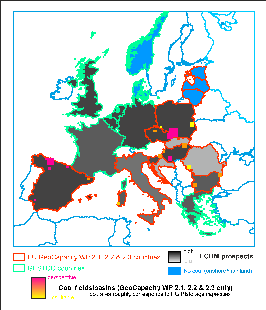In the case of coal fields, the screening criteria are not as elaborated as the criteria for saline aquifers and hydrocarbon fields. In the GESTCO project, entire basins have been studied, selected on the basis of known coal and coal bed methane resources (Tongeren and Laenen, 20012001 - P. C. H. van Tongeren and B. LaenenCoalbed methane potential of the Campine Basin (N. Belgium) and related CO2-sequestration possibilitiessee more; Bergen and Wildenborg, 20022002 - F. van Bergen and T. WildenborgInventory of storage potential of Carboniferous coal layers in the Netherlandssee more; May, 20032003 - F. MayCO2 storage capacity in unminable coal beds in Germany - GESTCO Project reportsee more). Areas of current coal exploitation were not considered. The upper depth limit of CO2Carbon dioxide injectionThe process of using pressure to force fluids down wells into coal beds might be restricted by previous or ongoing mining activities. The lower depth of the use of the CO2Carbon dioxide-ECBMEnhanced coalbed methane recovery: the use of CO2Carbon dioxide to enhance the recovery of the methane present in unminable coal beds through the preferential adsorptionThe adhesion of atoms, ions, or molecules from a gas, liquid, or dissolved solid to a surface of CO2Carbon dioxide on coal recovery (CO2Carbon dioxide injectionThe process of using pressure to force fluids down wells for Enhanced Coal Bed Methane recovery) was assumed as an economic limit - most likely up to 1500-2000 m, depending on the study area and the basinA geological region with sedimentary strata dipping towards a common axis or centre production history. Suitable areas or fields within coal basins can, in principle, be selected on the basis of higher content of (methane) gas in place - for example in Belgian basins (Tongeren and Laenen, 20012001 - P. C. H. van Tongeren and B. LaenenCoalbed methane potential of the Campine Basin (N. Belgium) and related CO2-sequestration possibilitiessee more), the value of at least 250 mln m3/km2 was recommended.
Similar criteria were applied in the EUEuropean Union GeoCapacity project (Wójcicki et al., 20072007 - A. Wójcicki, V. Hladik, V. Kolejka, M. Hamor-Vido, E. Hegedus, C. S. Sava, M. Car, M. Markic, R. Martinez, A. Arenillas, I. Suarez and G. GeorgievAssessment of potential for CO2 usage in coal fieldssee more; Vangkilde-Pedersen et al., 2008), in which the recommended depth range was 1-2 km. The presence of coal bed methane reserves is an additional important factor (the definition of reserves depends on country, basinA geological region with sedimentary strata dipping towards a common axis or centre and economic considerations - cf. Fig. 2-4 and Tab. 2-3). Areas and depth ranges were ongoing or abandoned mining activities have taken place were not recommended due to safety reasons.
| Tab. 2-3: General criteria for coal beds (used in the GESTCO and EUEuropean Union GeoCapacity projects). | Criterion | Safety | Depth | Gas in place | | Recommendations | Beyond area and depth range of mining activities | Upper: see-Safety; Lower: 1000-2000 m | Known reserves (economic, e.g. 250 Mm3/km2) (Mm3=106 m3) | |
| 
Fig. 2-4: Estimated CO2Carbon dioxide-ECBMR potential of EUEuropean Union GeoCapacity & GESTCO countries - after Wójcicki et al., 20072007 - A. Wójcicki, V. Hladik, V. Kolejka, M. Hamor-Vido, E. Hegedus, C. S. Sava, M. Car, M. Markic, R. Martinez, A. Arenillas, I. Suarez and G. GeorgievAssessment of potential for CO2 usage in coal fieldssee more |